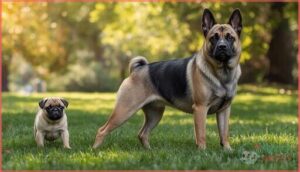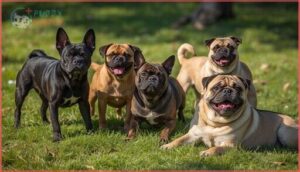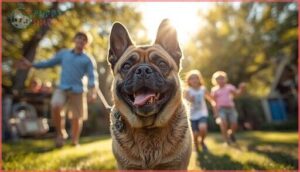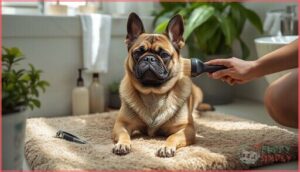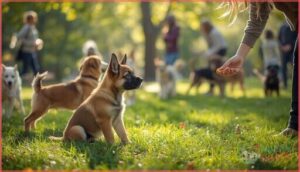This site is supported by our readers. We may earn a commission, at no cost to you, if you purchase through links.
A German Shepherd’s sharp gaze. A Pug’s comic timing. When you blend these worlds, you get the Shug—a pup with the brain power of a working dog and the mischief of a couch comedian. These compact companions sport wrinkled brows, curled tails, and enough curiosity to fuel every neighborhood walk.
German Shepherd Pug mixes turn heads at the dog park with their big personalities and signature looks, but there’s more to owning a Shug than quirky photos and cuddles on the couch. If you’re sizing up this one-of-a-kind mix, you’ll want the inside scoop on everything: price, care, health quirks, and whether this crossbreed fits your life.
Table Of Contents
- Key Takeaways
- What is a German Shepherd Pug Mix?
- Shug Appearance and Physical Traits
- Shug Temperament and Personality
- Parent Breed Histories
- Shug Health and Common Issues
- Shug Exercise and Activity Needs
- Shug Diet and Nutrition Guide
- Grooming and Maintenance for Shugs
- Shug Training and Socialization
- Shug Puppy Cost and Buying Tips
- Frequently Asked Questions (FAQs)
- Are Shugs recognized by any kennel clubs or organizations?
- How do Shugs typically react to strangers and new environments?
- What is the typical daily routine for a Shug?
- How do Shugs react to being left alone?
- Are Shugs suitable for first-time dog owners?
- Can Shugs adapt well to travel and new environments?
- Do Shugs require special training tools or equipment?
- Conclusion
Key Takeaways
- Shugs are medium-sized mixes with the German Shepherd’s cleverness and the Pug’s playful charm, creating loyal, affectionate dogs that thrive on companionship.
- Expect a wide range of looks and personalities in this crossbreed, with distinctive features like curled tails, wrinkled brows, and variable energy levels.
- Shugs are generally healthy and live 12–15 years, but they can inherit respiratory and weight issues from the Pug side, so regular exercise and vet care are essential.
- From purchase costs ranging $500–$2,000 to specific grooming, training, and socialization needs, owning a Shug requires thoughtful planning and ongoing commitment.
What is a German Shepherd Pug Mix?
A German Shepherd Pug mix, often called a Shug, is exactly what it sounds like—a cross between two dogs that couldn’t be more different. You get a medium-sized pup with the German Shepherd’s smarts and the Pug’s goofy charm, all wrapped up in a stocky, lovable package.
Let’s break down what makes this designer breed tick, from where it came from to how breeders bring these unique dogs into the world.
Breed Overview
The German Shepherd Pug Mix, often called a Shug, is a designer dog that’s captured hearts with its unique blend of traits. This hybrid combines a purebred German Shepherd with a purebred Pug, creating a medium-sized companion that showcases the best of both worlds.
While breed recognition from major kennel clubs remains unofficial, the Shug’s distinctive characteristics and charming personality have made it increasingly popular among dog lovers. These mixes are known for their loyal and protective nature.
Origin and Development
Designer dog breeding kicked off in the early 2000s, and that’s when hybrids like the Shug began appearing. First mentions popped up around the early 2010s, mainly in the United States. Here’s what you should know about this hybrid’s development:
- Most Shugs result from intentional pairings rather than accidental meetings
- They’re not recognized by major kennel clubs like the AKC
- Smaller hybrid registries occasionally document them
- Social media boosted their popularity in the late 2010s
As with other breeds, Shugs can inherit health issues from their Pug parent.
Breeding Process
Breeding German Shepherds and Pugs requires careful planning. Responsible breeders prioritize genetic compatibility and health screening to prevent hereditary issues such as hip dysplasia or breathing problems. Here’s an overview of the typical dog breeding process:
| Breeding Stage | Key Actions | Timeline |
|---|---|---|
| Pre-Breeding | Health screening, DNA tests | 2-4 weeks |
| Mating Methods | Natural or artificial insemination | 1-3 days |
| Pregnancy | Monitoring, vet checks | 63 days |
Ethical breeding standards mandate a minimum of one year between litters. Typically, a Shug litter consists of 5-8 puppies.
Shug Appearance and Physical Traits
When you picture a Shug, you might wonder what this unusual mix really looks like. These dogs don’t follow a cookie-cutter pattern since they blend two very different breeds.
Let’s walk through what you can usually expect with regard to their size, coloring, and standout features.
Size and Weight
You’ll notice quite a bit of weight variation in this breed—adult Shugs generally stand between 10 and 15 inches tall and weigh anywhere from 13 to 50 pounds. Your Shug’s adult height and body proportions depend largely on which parent breed they take after.
Pug-dominant dogs stay closer to the lower end, while German Shepherd traits push toward that 50-pound mark.
Puppy growth happens fastest between three and six months.
Coat Colors and Patterns
Your Shug’s coat colors range widely—cream, tan, black, brown, and white dominate about 80% of the breed. Color inheritance from both parents creates surprising variety, though black-and-tan and solid cream appear most often. Pigment intensity and pattern distribution vary by genetics, affecting everything from coat texture to rare colors like blue or silver.
- Solid coats make up half of all Shugs
- Bicolor patterns (black-tan, brown-cream) show in 25%
- Black facial masks appear in 30% of lighter dogs
- Brindle striping occurs in under 3% of litters
Distinctive Features
You’ll spot your Shug by its curled tail—practically a trademark of this German Shepherd Pug Mix appearance. Facial wrinkling clusters near the nose, giving your dog that signature squished profile. Ear carriage varies wildly; some stand tall, others flop down.
The body build stays compact yet muscular, often with a broad forehead showing visible skin folds. These hybrid markers make Shug characteristics unmistakable.
Shug Pictures Gallery
Pictures reveal the true range of German Shepherd Pug Mix Appearance—some Shug puppies sport compact, wrinkled facial features, while others lean toward a sleeker body structure. Coat coloration spans black, tan, cream, and brindle.
Puppy growth varies widely; at seven months, weights can hit 37 pounds.
Browse updated galleries from 2024 and 2025 for image authenticity. You’ll see Shugs cuddling kids and playing fetch, showcasing their affectionate nature.
Shug Temperament and Personality
If you’re wondering whether a Shug is the right fit for your home, their personality is where things get interesting. These dogs blend two very different temperaments into one lovable package, and the result can surprise you.
Let’s look at what makes them tick, from how they bond with their families to how they handle daily life with kids.
Loyalty and Affection
When you bring a Shug into your home, you’re getting a four-legged shadow who won’t leave your side. Their owner attachment runs deep, with behavioral consistency that makes them standout family pets. Here’s what their affection displays look like:
A Shug is your loyal, four-legged shadow, always devoted and never far from your side
- They’ll follow you room to room, seeking constant closeness
- Physical contact becomes their love language—expect cuddles
- They greet you like you’ve been gone for years, not minutes
- Their family bonding extends to every household member equally
This consistent loyalty and devoted dog temperament make Shugs amazing companions who genuinely care about your well-being.
Energy Levels
Your German Shepherd Pug Mix falls somewhere between a couch companion and a hiking buddy. Most need around 60 minutes of daily exercise, though breed influence varies—some lean toward the Shepherd’s stamina while others embrace Pug laziness.
Activity patterns should mix walks with mental games to prevent obesity risks and destructive chewing. Their adaptability shines in apartments, provided you meet their dog exercise needs consistently.
Compatibility With Children
When properly socialized, Shugs as family dogs shine with affection and patience around kids, making them good with children in most households. However, their protective instincts can emerge during play, so child supervision matters—especially with toddlers.
Early socialization and bite prevention training help establish healthy family dynamics. Teaching both your family dog and children respectful boundaries turns potential rough play into lasting companionship through proper dog socialization.
Parent Breed Histories
To really understand your Shug, it helps to know where they came from. Both the Pug and German Shepherd bring their own rich histories to the mix, and those backgrounds shape a lot of what makes your dog tick.
Let’s take a quick look at each parent breed and how their traits show up in your Shug.
Pug Breed History
For over 2,000 years, the Pug dog history reveals this charming dog breed’s journey from Ancient Chinese Origins as a royal companion to gaining European Popularity in the 1500s. Here’s what shaped this beloved breed:
- Pugs lived in Chinese palaces around 400 B.C., treasured by nobility
- Dutch traders brought them to Europe in the 16th century
- Queen Victoria championed Companion Breed Development in the 1800s
- The American Kennel Club recognized Pugs in 1885 for Breed Standardization
- Recent Trends show Pugs remain popular among dog breeds worldwide
Influence on Shug Traits
When you bring home a Shug, Trait Dominance becomes a guessing game. Behavioral Genetics from both parents shape your German Shepherd Pug mix uniquely—some inherit the shepherd’s protective alertness while others lean toward the Pug’s playful charm.
Physical Variation shows up everywhere, from facial structure to energy levels.
Health Predispositions like respiratory issues reflect the Pug’s flat face, affecting your dog’s exercise tolerance and overall wellbeing.
Shug Health and Common Issues
Like any mixed breed, Shugs can inherit health issues from both their German Shepherd and Pug parents. Understanding what to watch for helps you keep your pup healthy and happy for years to come.
Let’s look at what you need to know about their lifespan, common concerns, and how to stay ahead of potential problems.
Lifespan Expectations
When you welcome a Shug into your home, you’re looking at a companion who’ll stick around for about 12 to 15 years—a solid dog lifespan that reflects hybrid vigor. Genetic factors from both parent breeds play a role, but lifestyle impact and consistent veterinary care make all the difference in keeping common ailments at bay.
- Breed comparison shows mixed breeds often outlive purebreds by over a year
- Female Shugs statistically live longer than males in most populations
- Preventative health screenings boost your dog’s health and longevity considerably
Respiratory and Weight Concerns
Unfortunately, Shugs inherit Pug breathing difficulties—your dog faces almost 54 times higher BOAS risk than other breeds, making panting and heat intolerance real concerns.
Obesity prevention matters too, since Pugs are three times more prone to weight problems. Comorbid conditions like dental disease often tag along with these breathing difficulties, so weight management through proper dog nutrition and exercise becomes essential for your Shug dog health conditions.
Preventative Healthcare
You’ll want to tackle Shug dog breed health problems head-on with smart prevention. Start vaccination protocols at 6-8 weeks with DHPP, follow up with rabies at 14-16 weeks, and maintain monthly parasite prevention beginning around 8 weeks.
Schedule routine exams annually to catch dog health issues early, brush teeth 2-3 times weekly for dental maintenance, and consider spay/neuter benefits at 14-16 weeks to prevent future dog health concerns.
Shug Exercise and Activity Needs
Your Shug isn’t a couch potato, but they’re not going to run marathons either. They fall somewhere in the middle—needing regular movement to stay happy and healthy without wearing you out in the process.
Let’s break down what kind of exercise keeps these quirky pups thriving.
Daily Exercise Requirements
Your German Shepherd Pug mix needs 60 to 120 minutes of exercise daily to stay healthy and happy. This Shug thrives on moderate activity intensity, burning calories while reducing sedentary risks like obesity and anxiety.
Adjust for life stage—puppies need shorter, frequent sessions while seniors prefer gentler walks. Weather adjustments matter too, so swap outdoor time for indoor mental games during extreme conditions.
Suitable Activities and Play
For your Shug, fetch games work beautifully—15-20 minute sessions twice daily reduce boredom and improve obedience. Tug-of-war builds bonding while teaching bite control, and social play with other dogs boosts confidence.
Set up a backyard agility course with tunnels and ramps to challenge that German Shepherd intelligence. Water play keeps them cool during warmer months while burning energy effectively.
Mental Stimulation Tips
Ever notice your dog’s eyes light up at a new challenge? Keeping your Shug sharp means mixing things up—think puzzle toy rotation, scent work benefits, or a quick five-minute training session. Try these:
- Swap toys to boost curiosity
- Play “find it” with treats
- Rotate activities each week
- Include social play with pals
- Teach new tricks regularly
Shug Diet and Nutrition Guide
Keeping your Shug healthy starts with what’s in their bowl. Here’s what you should know about their ideal diet, how much to feed, and which foods to skip.
Let’s break down the basics to keep your buddy in top shape.
Recommended Food Types
Looking to fuel your Shug’s energy and keep their tail wagging? Aim for dog food rich in protein content (32% to 43%) and a fat percentage around 17%–22%. Allergy formulas support sensitive stomachs. Here’s a quick guide:
| Key Focus | Top Picks (Brand/Formula) |
|---|---|
| Brand recommendations | Purina, Royal Canin, Hill’s |
| Supplement needs | Omega-3s, glucosamine |
| Allergy formulas | Grain-free, Good Grub Dog Food |
Portion Sizes and Feeding Schedule
Tailoring your Shug’s portion sizes is all about balance. Stick to a plan that keeps Puppy Feeding and Adult Portions aligned with real needs. Try this easy feeding routine:
- Feed puppies 3–4 times daily, small portions.
- Adults do best with two meals per day.
- Adjust for activity—active dogs need more.
- Regular Weight Monitoring means healthier Nutrition.
Foods to Avoid
Pay attention to what goes in your Shug’s bowl—some foods that seem innocent can cause harm. Grapes, chocolate, and onions are toxic ingredients. Watch for harmful additives in packaged treats, and skip unsafe bones and rich dairy. Stick to dog food that meets dog nutrition guidelines and keep common allergens in mind.
Here’s a handy chart:
| Avoid Completely | Why It’s Risky |
|---|---|
| Grapes/Raisins | Kidney failure risk |
| Chocolate/Caffeine | Toxic, causes seizures |
| Onions/Garlic | Damages red blood cells |
| Cooked Bones | Splinter, cause obstructions |
| Dairy (Ice Cream/Cheese) | Digestive upset/lactose issues |
Grooming and Maintenance for Shugs
Taking care of a Shug’s coat and nails doesn’t have to be complicated, but there are a few things you’ll want to stay on top of. Regular upkeep keeps them looking and feeling their best.
Here’s what you need to know about day-to-day grooming.
Coat Care and Shedding
You’ll notice shedding intensity can shift with the seasons, especially in spring and fall. The Shug’s coat texture—whether leaning sleek or wiry—calls for reliable grooming tools like a de-shedding brush each week.
Gentle dog grooming routines help manage coat colors and keep skin health in check. Consistency really does make dog grooming requirements for Shugs easier for everyone.
Bathing and Cleaning
Once you’ve tackled shedding, it’s time to think about Bathing Frequency and Cleaning Techniques for your Shug. Bathe every 6 to 12 weeks to support healthy Dermal Health—just enough to keep their coat fresh but not strip natural oils.
Use dog-specific, hypoallergenic shampoos, and clean those adorable face folds often, especially with seasonal factors stirring up dirt or moisture.
Nail, Ear, and Dental Care
Once your Shug is clean, don’t skip over paws, ears, or teeth. Prevent Nail Overgrowth Risks and Common Complications by trimming monthly. Weekly Ear Cleaning Methods, using vet-approved solutions, help dodge infections. For Dental Disease Prevention, brush every other day.
Remember, dog care requirements hinge on routine grooming, making these steps key for everyday dog health.
- Trim nails monthly
- Clean ears weekly
- Brush teeth often
- Check for injury regularly
Shug Training and Socialization
Raising a Shug means helping them learn the ropes early. Training and socialization go a long way in shaping their behavior.
Here’s what to focus on as you get started.
Basic Obedience Training
Did you know starting Shug dog training around 8–16 weeks sets your pup up for life? Stick to short 10–15 minute sessions—think bursts, not marathons.
Use treats, toys, and praise for maximum effect; positive reinforcement speeds up learning and keeps your dog motivated.
Mix in real-life socialization training for a confident, well-mannered companion.
Housebreaking Tips
Because early housetraining shapes your Shug’s future habits, start with clear routine scheduling—think crate training paired with regular outdoor trips. Puppies learn fastest when positive reinforcement is immediate and calm. For best results:
- Stick to set bathroom breaks.
- Praise and treat after outdoor potty.
- Watch for accident signs—quick action is key in dog obedience training.
Socializing With Pets and People
With the right approach during those critical periods, you’ll see your Shug’s playful personality blossom. Early socialization is your best tool for building breed compatibility, smoothing dog behavior, and preventing anxiety down the road.
Friendly meetups with pets and people mean your dog’s temperament will shine—intervention outcomes show well-socialized Shugs grow into confident companions, not nervous wallflowers.
Shug Puppy Cost and Buying Tips
Getting a Shug puppy is exciting, but it’s smart to know what to expect before you bring one home. The cost can vary quite a bit, and there are a few important things you’ll want to look out for along the way.
Here’s what you should keep in mind as you start your search.
Average Price Range
Curious about Shug cost and purchase? Expect to spend anywhere from $500 to $2,000 for a German Shepherd Pug Mix puppy, depending on where you look and who you buy from. Here’s a peek at the dog breed price realities:
- Breeder reputation boosts the price
- Regional variance changes costs
- Seasonal shifts create spikes
- Seller type matters a lot
Factors Affecting Cost
Shug cost isn’t just a coin flip—dog price is shaped by more than looks alone. Breeder expenses, health costs, and even demand factors like regional shortages or designer popularity all play a part.
Pedigree lineage, health screenings, and location compliance fees can push the German Shepherd Pug Mix cost higher. The true cost of owning a Shug adds up fast!
Finding Reputable Breeders
Looking for a Shug puppy? Don’t just choose the first dog breeder who pops up online. Focus on breeder verification—ask about memberships and insist on health guarantees. Check waitlist trends, study reviews, and don’t skip reputation checks.
Ethical practices matter—responsible dog breeding practices protect your puppy’s future. Finding German Shepherd Pug Mix Puppies should feel safe, transparent, and thoughtful.
Adoption Vs. Purchase Considerations
You want to balance heart and wallet when choosing a Shug. Adoption benefits go beyond saving money—a typical dog adoption process covers shots, spay/neuter, and microchip, slashing your first-year cost breakdown.
Breeder ethics can vary, and legal agreements with shelters protect both you and your pup.
Shelter availability for mixed-breed puppies changes fast, so timing and patience truly matter.
Frequently Asked Questions (FAQs)
Are Shugs recognized by any kennel clubs or organizations?
Picture a dog with no official breed standard—Shugs aren’t recognized by major kennel clubs.
Still, designer breed registries like DDKC, ACHC, IDCR, and DRA allow registration benefits through ancestry documentation, though show eligibility remains limited.
How do Shugs typically react to strangers and new environments?
Most Shugs show initial stranger wariness and may hesitate in new places, reflecting their mixed breed temperament.
Early socialization, patience, and acclimation techniques help them adapt, boosting confidence and turning cautious behavior into relaxed interactions over time.
What is the typical daily routine for a Shug?
Think of a Shug’s day as a gentle rhythm: morning exercise and training, a midday potty break, afternoon play, evening grooming routines, and monitoring activity and health, all fit between restful sleep patterns that keep this little companion thriving.
How do Shugs react to being left alone?
Most Shugs crave company—after about 4–6 hours alone, separation anxiety signs kick in. Expect barking or chewing if bored, but interactive toys and a steady routine help ease destructive behavior triggers and nurture a balanced dog temperament.
Are Shugs suitable for first-time dog owners?
Inviting a Shug into your life is like welcoming a spirited new kid to the playground—enthusiastic and needing guidance.
They fit first-time owners with patience for dog training, consistent exercise commitment, and attention to grooming demands.
Can Shugs adapt well to travel and new environments?
Early socialization helps your Shug adjust to new places and routines, making travel smoother.
Look for travel stress signs, like panting or clinginess, but with the right coping strategies, their adaptable personality can shine in any environment.
Do Shugs require special training tools or equipment?
It’s almost funny—training a Shug isn’t as simple as tossing a stick. You’ll want puzzle feeders, chew toys, a chest plate (not a collar), and a sturdy crate.
Good hydration solutions and practical dog training methods seriously make a difference.
Conclusion
Finding a German Shepherd Pug mix in your life is like stumbling upon a hidden trail that promises both adventure and laughter with every step. This crossbreed isn’t simply a quirky photo-op—it’s an invitation to experience a new kind of dog companionship.
If you’re captivated by shug pictures, cost to buy, and all the rest, remember: what sets this mix apart isn’t just looks, but their knack for turning daily life into something truly unforgettable.
- https://articles.hepper.com/shug/
- https://a-z-animals.com/animals/german-shepherd-mix/
- https://www.rvc.ac.uk/vetcompass/news/new-research-shows-pugs-have-high-health-risks-and-can-no-longer-be-considered-a-typical-dog-from-a-health-perspective
- https://www.instagram.com/p/DEGG2sqyh-o/?hl=en
- https://www.dogbreedinfo.com/s/shug.htm


